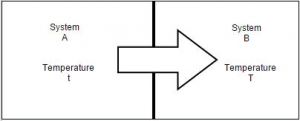This set of Heat Transfer Multiple Choice Questions & Answers (MCQs) focuses on “Modes Of Heat Transfer”.
1. The literature of heat transfer generally recognizes distinct modes of heat transfer. How many modes are there?
a) One
b) Two
c) Three
d) Four
View Answer
Explanation: There are three modes of heat transfer i.e. radiation, convection and conduction.
2. Consider system A at uniform temperature t and system B at another uniform temperature T (t > T). Let the two systems be brought into contact and be thermally insulated from their surroundings but not from each other. Energy will flow from system A to system B because of

a) Temperature difference
b) Energy difference
c) Mass difference
d) Volumetric difference
View Answer
Explanation: Greater the temperature imbalance the higher would be the rate of energy transfer.
3. An oil cooler in a high performance engine has an outside surface area 0.12 m2 and a surface temperature of 65 degree Celsius. At any intermediate time air moves over the surface of the cooler at a temperature of 30 degree Celsius and gives rise to a surface coefficient equal to 45.4 W/ m 2 K. Find out the heat transfer rate?
a) 238.43 W
b) 190.68 W
c) 543.67 W
d) 675.98 W
View Answer
Explanation: Q = (T2 – T1) A h = 0.12 (65-30) 45.4 = 190.68 W.
4. Unit of the rate of heat transfer is
a) Joule
b) Newton
c) Pascal
d) Watt
View Answer
Explanation: Unit of heat transfer is Joule but the rate of heat transfer is joule per second i.e. watt.
5. Convective heat transfer coefficient doesn’t depend on
a) Surface area
b) Space
c) Time
d) Orientation of solid surface
View Answer
Explanation: It is denoted by h and is dependent on space, time, geometry, orientation of solid surface.
6. The rate equation used to describe the mechanism of convection is called Newton’s law of cooling. So rate of heat flow by convection doesn’t depend on
a) Convective heat transfer coefficient
b) Surface area through which heat flows
c) Time
d) Temperature potential difference
View Answer
Explanation: It is directly proportional to all of above except time.
7. How many types of convection process are there?
a) One
b) Three
c) Four
d) Two
View Answer
Explanation: Forced, natural and mixed convection.
8. Thermal conductivity is maximum for which substance
a) Silver
b) Ice
c) Aluminum
d) Diamond
View Answer
Explanation: Thermal conductivity of diamond is 2300 W/m K.
9. A radiator in a domestic heating system operates at a surface temperature of 60 degree Celsius. Calculate the heat flux at the surface of the radiator if it behaves as a black body
a) 697.2 W/m2
b) 786.9 W/m2
c) 324.7 W/m2
d) 592.1 W/m2
View Answer
Explanation: As, q = Q/A = 5.67 * 10-8 (273+60)4 = 697.2.
10. Which of the following is an example of forced convection?
a) Chilling effect of cold wind on a warm body
b) Flow of water in condenser tubes
c) Cooling of billets in the atmosphere
d) Heat exchange on cold and warm pipes
View Answer
Explanation: In forced convection, the flow of fluid is caused by a pump, fan or by atmospheric winds.
Sanfoundry Global Education & Learning Series – Heat Transfer.
To practice all areas of Heat Transfer, here is complete set of 1000+ Multiple Choice Questions and Answers.
If you find a mistake in question / option / answer, kindly take a screenshot and email to [email protected]
- Practice Chemical Engineering MCQs
- Apply for Mechanical Engineering Internship
- Check Chemical Engineering Books
- Apply for Chemical Engineering Internship
- Check Mechanical Engineering Books
